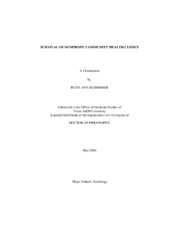| dc.description.abstract | In the provision of public goods such as health care for the uninsured, nonprofit
organizations serve important functions in society. Because they often rely on volunteer
labor, and funding is frequently unstable, their survival depends on factors not present in
either private enterprise or state agencies. This comparison case study examines three
clinics, one surviving clinic and two that did not survive, to find patterns that
characterize organizational success and survival. Theories about public goods,
volunteering, and organizational coordination and communication provide insight into
different aspects of the case study. Data was gathered from 19 in-depth interviews with
individuals connected to the three clinics.
The analysis employs OstromÂ’s characterization of eight principles of
longstanding common-pool resource organizations, with slight adjustments for the
public goods setting. As expected, the successful clinic reflects more of the
characteristics, or possesses them to a greater degree, than the unsuccessful ones.
Specifically, the successful clinic reflects a greater degree of congruence between
organizational rules and local conditions (as evidenced by community support), and
collective-choice arrangements (as indicated by the presence of an actively engaged board of directors). In addition, the successful clinic is loosely nested with other
organizations, whereas the nonsurviving clinics were more tightly nested within local
organizations; the looser nesting allows for greater autonomy in decision-making.
Finally, an unexpected finding drawn from the interviews concerns the manner in
which the clinics framed their message and mission. The successful clinic framed its
mission in terms of serving the “working poor,” whereas the nonsurviving clinics stated
their mission as charity for the poor and needy. This variance may have contributed to
greater community support for the successful clinic. | en |


